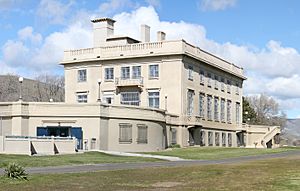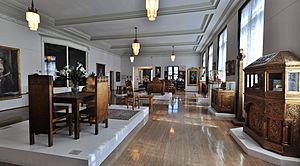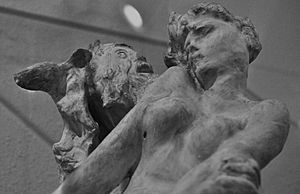Maryhill Museum of Art facts for kids
 |
|
| Established | 1940 |
|---|---|
| Location | near Maryhill, Washington |
Maryhill Museum of Art is a unique museum located near Maryhill, Washington. It sits on a high cliff overlooking the Columbia River Gorge. The museum has many different kinds of art and historical items.
The building was first planned as a large home for a businessman named Samuel Hill. He wanted to entertain his friend, King Albert I of Belgium, there. The house was named Maryhill after Hill's wife. Construction stopped when World War I began.
The unfinished building was officially opened on November 3, 1926, by Queen Marie of Romania. It opened to the public on May 13, 1940, which was Samuel Hill's birthday. In May 2012, the museum added a new section called the Mary and Bruce Stevenson Wing. This new part includes a plaza with river views, an education center, and a café.
Contents
What Can You See at Maryhill?
The Maryhill Museum has a wide variety of interesting collections. Here are some of the main things you can explore:
- Sculptures by Auguste Rodin: You can see plaster and bronze sculptures by the famous artist Auguste Rodin. These include parts of his well-known works like The Burghers of Calais and The Thinker.
- Paintings: The museum displays paintings from both Europe and America.
- Native American Art: There is a collection of art made by American Indian people. This includes baskets and beadwork from the Columbia Plateau area.
- Fashion Mannequins: You can see mannequins and tiny stage sets from the Théâtre de la Mode. These were used to show French fashion after World War II.
- Chess Sets: The museum has over 300 different chess sets from all over the world.
- Eastern Orthodox Icons: There are many Eastern Orthodox religious paintings, called icons. Some of these were given by Queen Marie of Romania.
- Queen Marie's Items: You can see furniture and personal items that belonged to Queen Marie.
- Loïe Fuller Memorabilia: There are items related to the famous dancer Loïe Fuller.
- Art Glass: The collection includes beautiful Art Nouveau glass pieces by artists like Émile Gallé and René Lalique.
- Samuel Hill Exhibit: A special exhibit tells the story of Samuel Hill's life and his many projects.
- Outdoor Sculpture Park: Outside, you can walk through a park with sculptures by artists from the Pacific Northwest.
- Maryhill Loops Road: This was the first asphalt road in Washington state, built in 1911. It is now famous for the annual Maryhill Festival of Speed, a gravity sports race.
Museum History and Growth
The Maryhill Museum building was designed by architects Hornblower & Marshall from Washington, D.C.. It was built in a grand Beaux-Arts style using steel-reinforced concrete, starting in 1914. Samuel Hill first imagined it as a ranch house for a large farming community he was creating.
From Home to Museum
In 1917, Hill's friend, the dancer Loïe Fuller, visited him. During her visit, Hill decided to change his unfinished home into "a museum for the public good." He wanted it to help promote French art in the American Northwest. Hill himself gave many items to the new museum. These included almost 90 American Indian baskets and over 70 sculptures and drawings by Rodin.
Loïe Fuller also helped the museum. She gave plaster casts of the hands of many famous people from that time. She also convinced her friends to donate their own items to the new museum.
Queen Marie's Contributions
When Queen Marie of Romania visited for the museum's dedication in 1926, she donated more than 100 objects. These gifts included her personal items, Romanian folk art, Russian icons, and different kinds of textiles. That same year, Queen Marie's oldest daughter, Elisabetha, who was once Queen of Greece, gave the museum a collection of small Tanagra figurines and ancient Cypriot amphorae (vases). A year before, the museum received its very first donation from Queen Marie's second daughter, Marie, Queen Consort of the Serbs, Croats and Slovenes. This first gift was three silver filigree objects.
Alma Spreckels' Support
Maryhill Museum also owes a lot to its fourth important supporter, Alma de Bretteville Spreckels. After Samuel Hill, Loïe Fuller, and Queen Marie passed away, Spreckels worked very hard to turn Hill's unfinished mansion into a real art museum.
Spreckels had collected many items from Queen Marie. These were originally meant for a "Romanian Room" in a museum in San Francisco. Instead, she donated these items to Maryhill Museum in 1938. This gift included Queen Marie's gold throne, unique Byzantine-style furniture, and a copy of her coronation crown. Spreckels also gave Maryhill a collection of art glass by artists like Émile Gallé and René Lalique.
The Théâtre de la Mode
Spreckels also helped bring the Théâtre de la Mode to Maryhill. These fashion mannequins were shown in Paris in 1945–1946 and then toured Europe and the United States. Their last stop in America was a museum in San Francisco. The organizers wanted to send them back to Paris, but they did not want to pay the customs fees. The mannequins were stored in a department store in San Francisco. Spreckels suggested that they be sent to Maryhill, and they arrived at the museum in time for the 1952 season.
Growing the Collections
Other people also helped the Maryhill art collection grow early on. Clifford Dolph, who was the museum's first director from 1938 to 1972, loved chess. He started collecting chess sets in 1957. Dolph also admired realist paintings. Many important artworks were bought during his time as director. He supported American artists who focused on realistic art. In 2000, the R. H. Ives Gammell Studios Trust gave the museum a series of 23 paintings called A Pictorial Sequence Painted by R. H. Ives Gammell Based on The Hound of Heaven. These paintings were first shown at Maryhill in 1957.
American Indian art has always been a key part of Maryhill Museum's purpose. Starting with Samuel Hill's own collection, the museum now has over 900 Indian baskets. In 1940, Mary Underwood Lane made a very important donation of Indian art. She was the granddaughter of Chief Welawa, also known as Chief Chenoweth. Her gift included items from the fur trade era and many carved, woven, and beaded objects from the Middle Columbia River region.
In 1979, a large collection of Arctic items was given to the museum. These came from the family of Harvey T. Harding, who ran a store in Nome, Alaska, from 1899 to 1907. Harding kept a diary of his experiences in the Arctic and carefully recorded the objects he collected. Many of these items are identified by where and when they were found.
The museum also has many old photographs, historical documents, and reference books.
Maryhill Stonehenge
The Maryhill Stonehenge is a concrete copy of the famous Stonehenge in England. It is located at the eastern end of Maryhill Museum's property, about four miles from the main museum building. Samuel Hill ordered it to be built. It was dedicated in 1918 as a memorial to local soldiers who died in World War I. The monument was fully finished in 1929.
See also
 In Spanish: Museo de Arte Maryhill para niños
In Spanish: Museo de Arte Maryhill para niños



